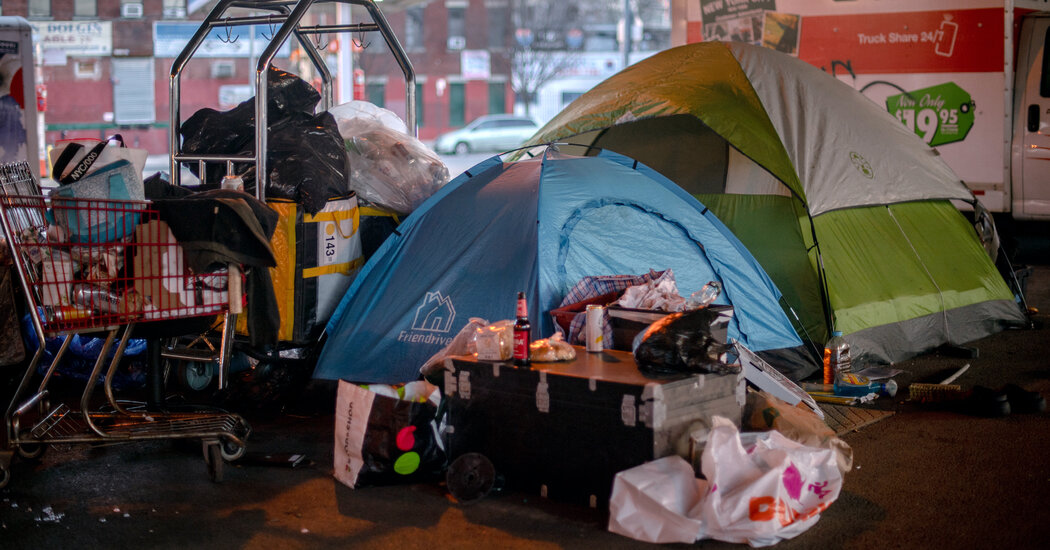|
Getting your Trinity Audio player ready...
|
In California, Gov. Gavin Newsom recently signed a law to make it easier to force treatment on people with certain mental illnesses. The mayor of Portland, Ore., said last week that he was considering similar measures. And in New York City, Mayor Eric Adams’s ongoing push for involuntary hospitalizations has already prompted weeks of public debate.
All three leaders, like others across the country, are facing the same sensitive challenge: how to house and treat severely mentally ill people living on the streets and subways who refuse medication. The group represents one of the most intractable and highly visible subsets of America’s homelessness crisis.
The roots of that crisis can be traced to the deinstitutionalization movement of the middle of the last century, when the fight for civil rights and hopes for new treatments precipitated the closure of decades-old public psychiatric hospitals. Many people with schizophrenia and other disorders were released. Over time, they struggled, in part because of inadequacies in housing supply and in supportive care services. Nationwide, thousands or more ended up living on the streets or cycling through temporary shelters, jails and emergency rooms; some became a threat to themselves or others.
Their plight has become even more acute recently. Disruptions associated with the Covid pandemic, fast-rising costs of living and fluctuating public funding for mental health treatment have exacerbated homelessness in all its forms. And some politicians have blamed mentally unstable people for upticks in some types of crime.
There is no clearer example than New York City, which is the focus of today’s newsletter. The full effect of Adams’s proposals may take years to understand. But the debate they have already prompted — including opposition from unexpected places — helps illustrate what is at stake.
New York’s plan
The city’s program is designed to help a small segment of the overall homeless population: a group of at least hundreds of people known to have untreated mental illness so severe that it prevents them from meeting their basic needs. (My colleagues explained it in detail here.) In an address announcing the shift, Adams said the city had a “moral obligation” to intervene.
Adams’s critics quickly pointed out that he was battling concerns about another problem — crime. He has said that people with “mental health issues” are driving increases in subway crime, though researchers say only a small percentage of serious crime can be attributed to mental illness.
The city has long had the ability to send members of that smaller group of severely mentally ill people to hospitals for care. Adams has directed police officers and other city workers to make the practice more common — not just for people who become violent but for those deemed to be in an acute psychiatric crisis that threatens their safety.
Adams’s administration hopes that its policy will help stabilize those who desperately need it. It also wants hospitals to house those patients until plans for outside care are in place.
Widespread opposition
Adams’s plan immediately inspired a storm of criticism. Some warned that the practice could traumatize already unstable individuals or threaten their civil liberties. Others pointed out that New York had a significant shortage of psychiatric hospital beds and the type of supportive housing needed for treatment plans to stick. Even Adams conceded the recent steps were just the start of trying to right a complex system.
But almost as notable as the criticism were the critics themselves. Liberal politicians and nonprofit groups that tend to the homeless community sounded alarms, and so did New York’s influential policing community with which the groups often disagree.
Years of meaningful public protest around how the police treat civilians, inflation and relatively low pay have sapped morale and created a growing shortage in the ranks of the New York Police Department. Patrick J. Lynch, the president of New York’s major police union, said the new policy would put “a strain on our severely understaffed, overworked and underpaid ranks.”
There is another pressing question: Should police officers be the ones interacting with a severely mentally ill person on the street? Officers are not trained to be health experts, and encounters with emotionally disturbed people can escalate quickly.
Kim Hopper, a Columbia University professor who has spent decades focused on the nexus of homelessness and mental illness in New York, outlined additional concerns. He said Adams’s new initiative amounted to a rehash of failed mental health efforts in an earlier generation. He said he worried that the city’s policy would simply shuffle people through emergency rooms, shelters and the streets without addressing structural problems like shortages of housing and funding for support programs.
“It’s the same trap, but its being offered as the new compassion,” he told me. “We know, and they know, this is not going to work.”
Related: Some Black leaders in New York compared criticism of Adams to the experience of the city’s first Black mayor, David Dinkins.
THE LATEST NEWS
Trump’s Taxes
Business
-
Elon Musk said he would step down as Twitter’s C.E.O. when he finds a replacement. He will remain the company’s owner.
-
Wells Fargo was ordered to pay $3.7 billion to settle claims that it had harmed millions of people with its banking violations, including mismanaging mortgages and auto loans.
Other Big Stories
Opinions
In China, zero Covid has become “you’re on your own,” Eva Rammeloo writes.
Fentanyl use exploded while the government slept, The Washington Post’s editorial board argues.
MORNING READS
Lives Lived: Kim Simmonds led Savoy Brown, a seminal British blues band, for more than 50 years. Though the band’s personnel changed frequently, Simmonds’s guitar work and songwriting melodicism kept its musical vision consistent. He died at 75.
SPORTS NEWS FROM THE ATHLETIC
A new era in Phoenix: Mat Ishbia, a billionaire mortgage lender, is buying a majority share of the N.B.A.’s Suns and W.N.B.A.’s Mercury in a deal that values the teams at $4 billion.
Chicago stars: The Bulls have held multiple team meetings to work out issues between players Zach LaVine and DeMar DeRozan.
LIV golfers eligible: Augusta National will make no changes to its invite criteria for the 2023 Masters. As a result, 16 players from the LIV league are on the list.
ARTS AND IDEAS
Why hit songs sound so familiar
A strange phenomenon appeared on the pop music charts this year: Many of the catchiest songs were also the catchiest songs of 2007, or 1998, or 1987. Artists increasingly turned to already-famous tunes and samples to supercharge their singles, the Times critic Jon Caramanica writes.
On the rapper Jack Harlow’s new album, he uses the strategy twice: The song “First Class” relies on a sample of Fergie’s “Glamorous,” a Billboard No. 1 from 15 years ago; and “Side Piece” samples Snoop Dogg and Pharrell Williams’s “Beautiful,” a No. 6 hit in 2003.
“It’s a way to harness pre-existing star power, or familiarity, as a proxy for generating your own,” Jon writes. “A cheat code.”
Hear examples of borrowed pop hits, including three that reached No. 1 this year.



